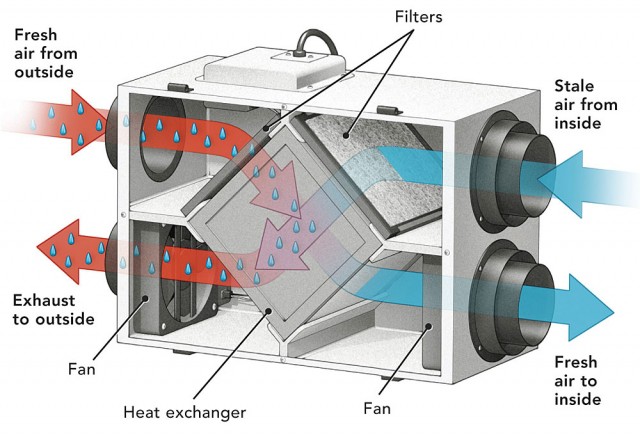The All-Inclusive Overview to the Uses of Heat Recovery Ventilation in Modern Buildings
Heat Recovery Ventilation (HRV) systems stand for a considerable development in constructing innovation (HRV Heat Recovery Ventilation). They offer an approach for exchanging stagnant indoor air with fresh exterior air while reducing power loss. This method not just boosts indoor air top quality but additionally contributes to power performance in both residential and business buildings. Comprehending the numerous applications and advantages of HRV can expose its critical role in modern layout and sustainability efforts. The implications of this modern technology are worth exploring further
Understanding Heat Recovery Ventilation Solutions

Several modern-day buildings prioritize power efficiency, understanding warm recuperation ventilation (HRV) systems is important for enhancing indoor air high quality and lowering energy consumption. HRV systems work by transferring warm from stagnant indoor air to incoming fresh air, effectively maintaining comfortable indoor temperatures while lessening power loss. These systems contain a warm exchanger, fans, and ductwork that facilitate the flow of air. Throughout winter season, HRV devices record and recycle warmth from the outbound air, while in summertime, they can help cool incoming air. By constantly exchanging air, HRV systems also reduce humidity and the concentration of interior pollutants. Proper installment and upkeep of HRV systems are crucial for their effectiveness and efficiency in improving general structure efficiency and comfort.
Benefits of Heat Recovery Ventilation
Heat recovery ventilation systems provide many advantages that improve both power effectiveness and interior air high quality in modern buildings. By recording and recycling power from exhaust air, these systems greatly decrease heating & cooling costs, bring about lower power consumption. Moreover, they maintain a steady flow of fresh outside air, decreasing the danger of indoor air toxins and irritants. This constant exchange aids control humidity degrees, protecting against mold and mildew growth and making certain a healthier living setting. Additionally, HRV systems add to sustainability goals by lowering overall carbon footprints. Their capability to enhance ventilation without giving up thermal comfort makes them a beneficial addition to modern building style, advertising both financial and ecological advantages.
Applications of HRV in Residential Buildings
As home owners progressively prioritize power efficiency and interior air quality, the applications of warm recovery air flow (HRV) systems in domestic structures have ended up being extra widespread. HRV systems are especially helpful in securely sealed homes, where preserving fresh air blood circulation is vital for protecting against moisture buildup and interior contaminants. They efficiently move heat from outbound stagnant air to inbound fresh air, minimizing power prices related to heating and cooling. Additionally, HRVs can enhance convenience levels by managing moisture and temperature level. They are also adaptable for numerous residential designs, including single-family homes and multi-unit buildings. On the whole, incorporating HRV systems supports sustainable living techniques while making certain a much healthier interior atmosphere for passengers.
HRV in Business and Commercial Settings
In business and commercial setups, the execution of warm recovery ventilation (HRV) systems has actually come to be significantly vital for maximizing power effectiveness and maintaining air high quality. These systems properly move warm from exhaust air to incoming fresh air, decreasing the demand for additional heating or air conditioning. This not only decreases power costs however also contributes to sustainability initiatives. Industries such as manufacturing, warehousing, and office complex benefit read the article considerably from HRV systems, as they help manage temperature level and humidity degrees, making sure a comfortable and productive setting. HRV systems help in eliminating contaminants and excess wetness, enhancing indoor air top quality. As guidelines around air high quality become more stringent, the adoption of HRV technology is most likely to grow, making it a crucial part of modern business and commercial framework.
Future Patterns in Heat Recovery Ventilation Modern Technology

Often Asked Concerns
How Does Heat Recovery Ventilation Influence Indoor Air Top Quality?
Heat recovery ventilation considerably boosts interior air top quality by constantly trading stale indoor air with fresh exterior air while recouping power. This procedure lowers toxins, preserves optimal moisture levels, and guarantees a much healthier atmosphere for residents.
Can HRV Systems Be Set Up in Existing Structures?
HRV systems can certainly be installed in existing structures. Retrofitting may require alterations to ductwork and ventilation layouts, yet it significantly enhances power performance and indoor air quality, making it a sensible choice for older structures.
What Upkeep Is Required for HRV Equipments?

Exist Certain Climates Where HRV Is Much More Reliable?
Heat recovery ventilation systems are especially effective in climates with considerable temperature distinctions in between periods. These systems enhance energy effectiveness by recouping warm from exhaust air, making them suitable for both chilly and moderately cozy settings.
Exactly How Do HRV Systems Affect Power Bills?
